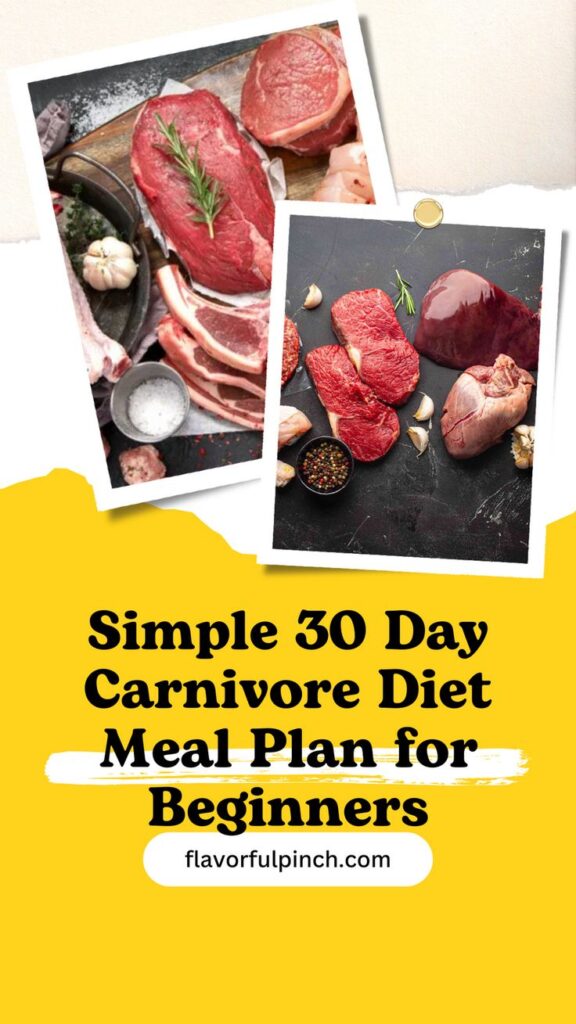The carnivore diet is a comprehensive, meat-based nutritional strategy that has captured the attention of health-conscious people all over the world.
This dietary approach is as straightforward as it is challenging, it emphasizes the intake of just animal products and excludes all plant-based products.
The carnivore diet is particularly notable since it stands in contrast to conventional dietary recommendations, which call for a diet that is balanced in terms of fruits, vegetables, grains, and proteins.

The carnivore diet’s simplicity and promise of several health advantages are what make it so appealing. Supporters of this diet emphasize how it can lead to substantial weight loss, improved mental clarity, decreased inflammation, and better digestive health.
Furthermore, the diet is naturally satisfying because to its high protein and fat content, which frequently results in a decrease in total caloric intake without the need for exact calorie counting.
This diet is historically based on the dietary habits of our ancestors, who ate a lot of animal products.
These days, it has become more popular as an acceptable choice for people looking for a change from diets high in carbohydrates or for people with long-term health conditions that plant-based foods might affect.
To start a carnivore diet, however, one must have a thorough awareness of its principles, advantages, and negative effects.
A comprehensive 30-day meal plan for beginners is provided in this article, along with helpful advice to help you follow this nutritional plan.
This article aspires to give you the understanding and assistance you need to succeed, whether your goal is to start your health journey or experiment with new eating habits.
Other Related Recipes That You’ll Like To Try
Carnivore Baked Chicken Nuggets
2 Ingredients Quick And Easy Carnivore Waffles
Coconut Cottage Cheese Ice Cream
Carnivore Creamy Egg Salad Dip Recipe
Menu Overview
One kind of elimination diet that involves solely consuming animal products is the carnivore diet. This covers meat, fish, eggs, and a few products made from animals, such as cheese and butter.
The fundamental idea is that the body goes into a state where it burns fat effectively and survives on protein and fat when all plant-based foods are eliminated.
This diet’s promoters say it may help with digestive issues, inflammation, and autoimmune diseases. This is a comprehensive list of the basic necessities:
Meats
- Beef: Including steak, ground beef, brisket, and ribs
- Lamb: Including lamb chops, shanks, and ground lamb
- Poultry: Chicken thighs, wings, and turkey
- Goat: Such as goat chops, bacon, and sausages
- Rabbit: Ground rabbit, legs, and meatballs
Fish and Seafood
- Salmon
- Shrimp
- Scallops
- Mackerel
- Sardines
Eggs
- Chicken eggs
- Duck eggs
Dairy (Optional)
- Butter
- Hard cheeses (cheddar, gouda)
- Heavy cream
Organ Meats
- Liver (beef, chicken)
- Kidney
- Heart
Bone Broth
- Beef or chicken bone broth, rich in collagen and minerals
Avoiding all plant-based foods, such as fruits, vegetables, grains, nuts, and seeds, is the main foundation of the carnivore diet. The body stops using carbs and starts using fats and proteins as its main energy sources.
Weight loss and better metabolic health are two of the many health advantages that can result from this change.
Benefits of Carnivore Diet
1. Weight Loss
The major protein and fat component of the carnivore diet encourages being full, which may result in consuming less calories overall. When there are no carbs in the diet, the body switches to a metabolic condition called ketosis, where it burns fat for energy.
This can lead to significant weight loss, especially for people who have had difficulty with traditional weight-loss methods.
2. Enhanced Mental Clarity
Many carnivore diet followers report increased mental clarity and cognitive efficiency. The elimination of inflammatory foods that can impair brain function and the stabilization of blood sugar levels are frequently associated with this effect.
Furthermore, ketones, the product of fat metabolism, are thought to be a more effective energy source than glucose and are what the brain uses to function.
3. Reduced Inflammation
Inflammation can be considerably decreased by avoiding plant-based foods, especially those that include anti-nutrients like lectins and phytates.
Because of this, those with autoimmune diseases or other chronic inflammatory problems may find the carnivore diet to be an appealing alternative. Certain animal products’ high omega-3 concentration also helps to reduce inflammation.
4. Improved Digestive Health
When switching to a carnivorous diet, many people find relief from digestive problems such gas, bloating, and irritable bowel syndrome (IBS).
The removal of plant fibers and other irritants that some people have trouble digesting is linked with this improvement.
5. Simplified Eating
The simplicity of the carnivorous diet is one of its most significant benefits. Meal preparation and planning are made considerably easier by concentrating only on animal products. Long-term diet compliance may be facilitated by this simplicity, which helps reduce decision-making fatigue.
Challenges of the Carnivore Diet
1. Nutritional Deficiencies
With the carnivorous diet, the possibility of deficiencies in nutrition is one of the main worries. By avoiding all plant-based foods, people might miss out on important nutrients like vitamin C and dietary fiber that are normally found in fruits and vegetables. To compensate for some of these deficiencies, include a range of seafood and organ meats.
2. Initial Adaptation Period
It might be difficult to switch to a carnivorous diet since the body has to adapt to a different metabolic state. The body switches from using carbs to fat as its main energy source during this time, which is sometimes called the “keto flu,” and can cause symptoms like headaches, exhaustion, and changes in digestion.
3. Social and Lifestyle Constraints
It can be difficult to maintain the carnivorous diet in social settings. Attending social events or dining out frequently requires navigating a small selection of foods that comply to the strict requirements of the diet. This might involve careful planning and a strong dedication to nutritional objectives.
4. Ethical and Environmental Concerns
The ethical and environmental effects of a diet high in meat are still up for disagreements. Animal welfare issues and the effects of meat production on the environment are among the concerns. Selecting animal products that are ethically farmed and obtained effectively can help ease some of these worries.
5. Long-term Sustainability
Because of its restrictive nature, the carnivore diet can be challenging to adapt to over the long term. In the long run, the lack of variety can cause dietary restlessness, and people may find it difficult to continue to the diet without a lot of dedication and help.
Important Considerations for Beginners
- Listen to Your Body
Given how limiting the carnivore diet is, it’s essential to monitor how your body responds. Changing your portion sizes or trying different animal products can be beneficial if you’re feeling really exhausted or having stomach problems.
- Hydration
Stay hydrated throughout the day by drinking lots of water. In order to avoid electrolyte imbalances, think about adding salt to your food or consuming bone broth to get extra minerals.
- Incorporate Organ Meats
Although they are optional, organ meats such as liver, kidneys, and heart should be consumed for a more balanced carnivore diet because they are rich in essential nutrients.
- Include Animal Fats
Don’t shy away from fatty cuts of meat. The carnivore diet requires a high intake of fats, and consuming fatty cuts like ribeye steaks and salmon can help you meet your energy needs.
- Quality of Meat
Select meat that is hormone-free, pasture-raised, and grass-fed whenever possible to get better nutrition. Including organ meats, such as liver, into your diet is also very helpful and nutrient-dense.
Detailed 30-Day Meal Plan
Week 1: Introduction and Adaptation
The goal of this first week is to establish the foundations. Basic animal products like beef, chicken, goat, and eggs will be consumed by you.
Day 1:
- Breakfast: Scrambled eggs with butter, bacon slices
- Lunch: Grilled ribeye steak, bone broth
- Dinner: Roasted chicken thighs, pan-seared salmon
Day 2:
- Breakfast: Hard-boiled eggs, sliced cheese
- Lunch: Ground beef patties, bone broth
- Dinner: Roasted chicken wings, sardines
Day 3:
- Breakfast: Fried eggs, bacon, cheddar cheese
- Lunch: Grilled goat chops, bone broth
- Dinner: Baked salmon with lemon butter
Day 4:
- Breakfast: Cheese omelet, goat sausages
- Lunch: Beef brisket, bone broth
- Dinner: Lamb chops, fried shrimp
Day 5:
- Breakfast: Scrambled eggs with heavy cream, bacon
- Lunch: Lamb shanks, bone broth
- Dinner: Pan-fried mackerel, buttered shrimp
Day 6:
- Breakfast: Fried eggs, bacon, cheddar slices
- Lunch: Rabbit legs, bone broth
- Dinner: Baked trout with lemon butter
Day 7:
- Breakfast: Cheese omelet, goat sausages
- Lunch: Grilled steak, liver sausages
- Dinner: Roasted turkey legs, scallops
Week 2: Increasing Variety
This week, while following to the fundamentals of the diet, there are a few more varied meat options.
Day 8:
- Breakfast: Scrambled eggs with liver, bacon
- Lunch: Beef ribs, bone broth
- Dinner: Grilled lamb chops, fried shrimp
Day 9:
- Breakfast: Cheese omelet, rabbit sausages
- Lunch: Ground beef patties, bone broth
- Dinner: Pan-baked mackerel, buttered shrimp
Day 10:
- Breakfast: Hard-boiled eggs, sliced cheese
- Lunch: Grilled goat chops, bone broth
- Dinner: Roasted chicken thighs, salmon fillet
Day 11:
- Breakfast: Scrambled eggs, bacon
- Lunch: Beef brisket, liver sausages
- Dinner: Roasted turkey legs, sardines
Day 12:
- Breakfast: Fried eggs, cheddar cheese
- Lunch: Lamb shanks, bone broth
- Dinner: Baked salmon with lemon butter
Day 13:
- Breakfast: Omelet with cheese, bacon
- Lunch: Grilled steak, bone broth
- Dinner: Pan-fried mackerel, fried shrimp
Day 14:
- Breakfast: Hard-boiled eggs, cheddar slices
- Lunch: Goat ribs, bone broth
- Dinner: Baked trout with lemon butter
Week 3: Advanced Meals and Experimentation
Now that you’re getting used to the diet, it’s time to try more varied and creative meals.
Day 15:
- Breakfast: Scrambled eggs with liver, bacon
- Lunch: Grilled lamb chops, bone broth
- Dinner: Pan-seared salmon, shrimp
Day 16:
- Breakfast: Cheese omelet, goat sausages
- Lunch: Ground beef patties, liver sausages
- Dinner: Roasted chicken thighs, mackerel
Day 17:
- Breakfast: Fried eggs, cheddar cheese
- Lunch: Rabbit legs, bone broth
- Dinner: Grilled lamb shanks, sardines
Day 18:
- Breakfast: Hard-boiled eggs, cheddar slices
- Lunch: Grilled steak, bone broth
- Dinner: Baked salmon with butter
Day 19:
- Breakfast: Scrambled eggs with heavy cream, bacon
- Lunch: Ground beef patties, liver sausages
- Dinner: Pan-fried mackerel, shrimp
Day 20:
- Breakfast: Cheese omelet, goat sausages
- Lunch: Grilled lamb chops, bone broth
- Dinner: Roasted turkey legs, scallops
Day 21:
- Breakfast: Fried eggs, bacon, cheddar slices
- Lunch: Goat ribs, bone broth
- Dinner: Baked trout with lemon butter
Week 4: Refinement and Consistency
By the last week, you should feel comfortable with the carnivore diet. Focus on maintaining balance and listening to your hunger cues.
Day 22:
- Breakfast: Scrambled eggs with liver, bacon
- Lunch: Grilled lamb shanks, bone broth
- Dinner: Pan-backed salmon, rabbit meatballs
Day 23:
- Breakfast: Cheese omelet, rabbit sausages
- Lunch: Ground beef patties, liver sausages
- Dinner: Roasted chicken thighs, mackerel
Day 24:
- Breakfast: Fried eggs, cheddar cheese
- Lunch: Goat ribs, bone broth
- Dinner: Grilled lamb chops, sardines
Day 25:
- Breakfast: Hard-boiled eggs, cheddar slices
- Lunch: Grilled steak, bone broth
- Dinner: Baked salmon with butter
Day 26:
- Breakfast: Scrambled eggs with heavy cream, bacon
- Lunch: Ground beef patties, liver sausages
- Dinner: Pan-fried mackerel, shrimp
Day 27:
- Breakfast: Cheese omelet, goat sausages
- Lunch: Grilled lamb chops, bone broth
- Dinner: Roasted turkey legs, scallops
Day 28:
- Breakfast: Fried eggs, bacon, cheddar slices
- Lunch: Goat ribs, bone broth
- Dinner: Baked trout with lemon butter
Day 29:
- Breakfast: Scrambled eggs with liver, bacon
- Lunch: Grilled lamb shanks, bone broth
- Dinner: Pan-seared salmon, shrimp
Day 30:
- Breakfast: Cheese omelet, goat sausages
- Lunch: Ground beef patties, liver sausages
- Dinner: Roasted chicken thighs, rabbit meatballs
A unique and simple eating routine, the carnivore diet can lead to weight loss and improved mental clarity, among other health advantages. But because of its limitations, it needs dedication and careful consideration.
With a priority on variety, nutrient richness, and helpful adherence advice, this 30-day meal plan offers a thorough guidance to assist beginners successfully navigate the carnivorous lifestyle.
For people who want to change their eating habits and reach their health objectives, this diet can be a life-changing experience with careful planning and dedication.





